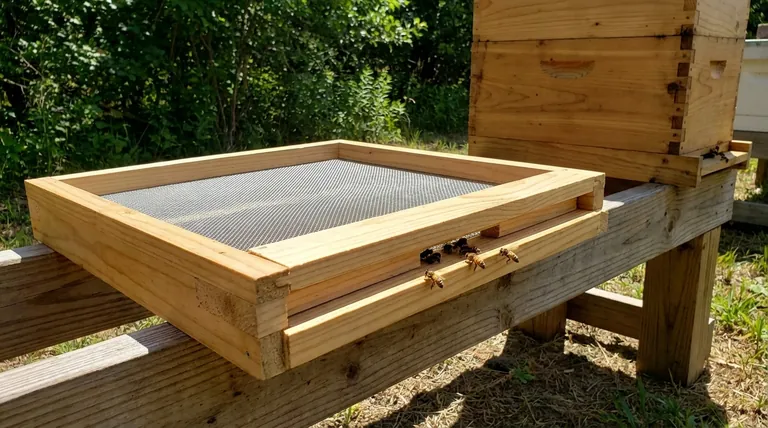At its core, the bottom board is the functional floor of the beehive. It serves as the hive's structural foundation, supports the full weight of the colony, and provides the primary entrance and exit that foraging bees use as a takeoff and landing platform.
Beyond simply being a floor, the bottom board is a critical piece of equipment that a beekeeper uses to regulate the hive's internal environment, manage pests, and protect the colony from the elements.

The Foundational Role: Support and Access
A bottom board provides the essential structure and entry point for the entire colony. Without it, the hive would be incomplete and exposed.
The Hive's Floor
The most obvious function is to serve as the floor of the colony. It creates an enclosed space, separating the bees from the ground below.
Structural Support
The bottom board bears the entire weight of the hive, which can be substantial. This includes the hive bodies, frames, honey, pollen, and the bee population itself.
The Entrance and Exit
This component incorporates the hive's "front door." This entrance acts as a runway for foraging bees to land and take off, and it is the point through which the colony manages all traffic.
A Critical Tool for Environmental Control
The type and placement of a bottom board directly impact the hive's ability to manage temperature, moisture, and its defense against weather.
Protection from the Elements
Placed on a hive stand, the bottom board elevates the colony, keeping it off the damp ground. Tilting the entire hive forward slightly ensures that any rainwater drains out rather than pooling inside.
Regulating Temperature and Wind
A solid bottom board is particularly effective in colder climates. It helps insulate the hive and reroutes cold wind chill away from the cluster, reducing the energy bees must expend to stay warm during winter.
Managing Ventilation
A screened bottom board provides excellent ventilation. This is crucial in hot and humid climates to prevent the hive from overheating and to help bees cure honey more efficiently.
Understanding the Trade-offs: Solid vs. Screened
Choosing a bottom board is not a one-size-fits-all decision. The choice between a solid or screened design involves clear trade-offs related to climate and pest management philosophy.
The Case for Solid Bottom Boards
Solid boards offer maximum protection from winter winds and cold. They create a more sealed environment that is easier for the bees to thermoregulate, making them a default choice in regions with harsh winters.
The Case for Screened Bottom Boards
Screened boards are a powerful tool for pest control, specifically against Varroa mites. As mites fall off bees, many will fall through the screen and out of the hive, providing a form of passive, chemical-free pest management.
The Reversible Option
Some bottom boards are reversible, offering two different entrance sizes. A larger opening can be used during the strong summer nectar flow for better ventilation, while a smaller opening can be used in winter to help the bees defend the hive more easily.
Making the Right Choice for Your Goal
Selecting the correct bottom board is a key decision that influences your colony's health and your management style.
- If your primary focus is winter survival in a cold climate: A solid bottom board is the superior choice for its insulating properties and protection from drafts.
- If your primary focus is ventilation and passive pest control: A screened bottom board is essential for managing Varroa mites and keeping the hive cool in hot weather.
- If you want maximum flexibility for all seasons: A screened bottom board with a removable insert gives you the benefits of both, allowing you to close it for winter and open it for summer.
Ultimately, understanding the function of the bottom board empowers you to create the ideal environment for your bees to thrive.
Summary Table:
| Function | Solid Bottom Board | Screened Bottom Board |
|---|---|---|
| Best For Climate | Cold winters, insulation | Hot, humid climates, ventilation |
| Pest Management | Limited | Passive Varroa mite control |
| Primary Advantage | Wind protection, warmth | Improved airflow, cooling |
Equip your apiary for success with HONESTBEE.
Choosing the right bottom board—solid, screened, or reversible—is crucial for colony health and productivity. As a trusted wholesale supplier for commercial apiaries and beekeeping equipment distributors, HONESTBEE provides durable, high-performance hive components designed for professional beekeeping operations.
Let us help you build a stronger foundation for your business. Contact our team today to discuss your wholesale needs and discover how our equipment supports thriving colonies.
Visual Guide

Related Products
- Langstroth Screen Bottom Board for Beekeeping Wholesale
- Australian Pine Wood Langstroth Screen Bottom Board for Wholesale
- Langstroth Solid Bottom Board for Beekeeping
- Multi-Functional Sliding Hive Entrance for Beekeeping
- Professional Galvanized Hive Strap with Secure Locking Buckle for Beekeeping
People Also Ask
- How should the screened bottom board be used throughout the year? A Guide for Healthy Hives
- What is the primary function of a screened bottom board in a hive? Enhance Ventilation & Control Varroa Mites
- What are some considerations when choosing between solid and screened bottom boards? Optimize Hive Health & Pest Control
- What are the benefits of a screened bottom board? Boost Hive Health & Control Varroa Mites
- What are the advantages of a screened bottom board? Boost Hive Health with Superior Ventilation & Pest Control



















